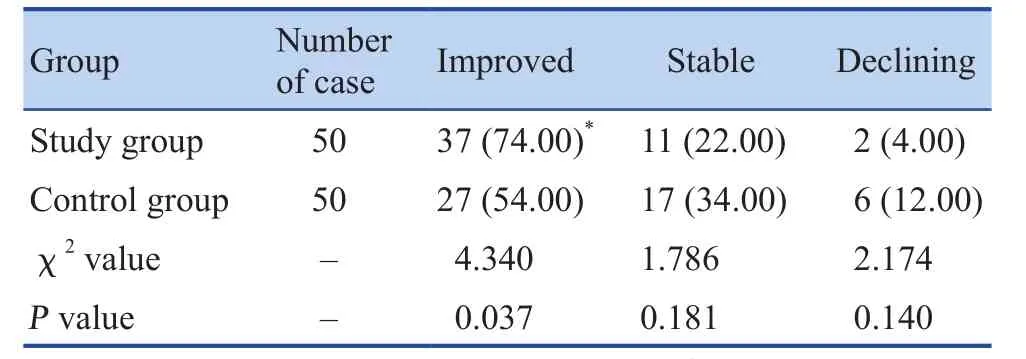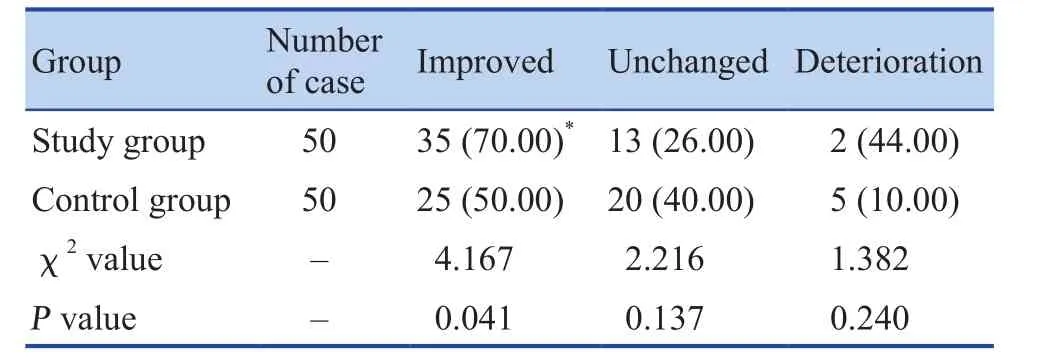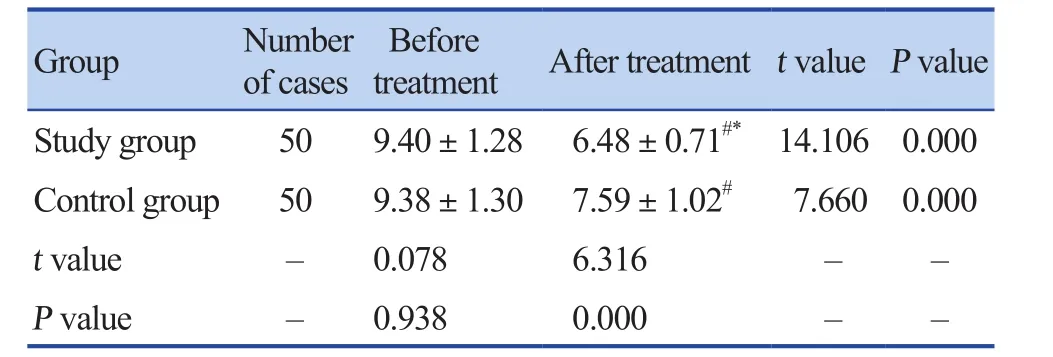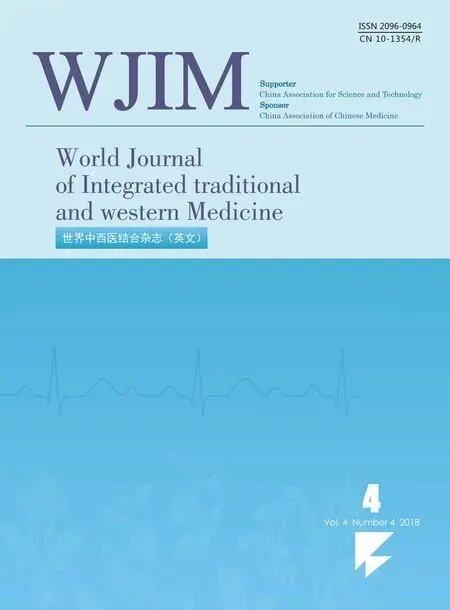Clinical Analysis of Erzhi Mingmu Decoction in the Treatment of Non-exudative Age-related Macular Degeneration
Jiang Yanhua (姜艷華), Li Ruoxi (李若溪), Qi Fei (齊 飛)
Ophthalmology Department, Shenyang Forth People's Hospital, Shenyang 110031, China
ABSTRACT OBJECTIVE: To study the effect of Erzhi Mingmu Decoction in the treatment of non-exudative age-related macular degeneration. METHODS: A total of 100 patients with non-exudative age-related macular degeneration admitted to our hospital from May 2017 to May 2018 were selected. They were randomly divided into the study group and the control group. The control group was treated with oral vitamin C and vitamin E while study group was treated with Erzhi Mingmu Decoction based on the same treatment of the control group. Both groups were continuously treated for 1 month,the visual improvement, fundus changes, and changes of serum VEGF and CRP levels were compared before and after treatment. RESULTS: The number of patients with visual improvement was higher in the study group than that in the control group (P < 0.05). The number of patients with fundus improvement in the study group was more than that of the control group (P < 0.05). Serum VEGF levels were decreased in the 2 groups after treatment, and they were decreased more in the study group than those in control group (all P < 0.05). Serum CRP levels were decreased in the 2 groups after treatment, and the serum CRP levels were decreased more in the study group than those in control group (all P < 0.05).CONCLUSION: The treatment of non-exudative age-related macular degeneration with Erzhimingmu Decoction can significantly improve the vision of patients, improve the condition of the fundus, and reduce the levels of serum VEGF and CRP, which is worthy of clinical promotion and application.
KEYWORDS: Non- exudative age-associated macular degeneration; Erzhi Mingmu Decoction; Vision; Vascular endothelial growth factor; C-reactive protein
Age-related macular degeneration, also known as senile macular degeneration, occurs mostly in middleaged and older people over the age of 50, and most of the patients have successive or simultaneous attack of both eyes, which is one of the most important blindness disease that causes reduction of clinical visual function in middle-aged and elderly people.[1]And related research data shows that with the increasing ageing of Chinese population, the incidence of age-related macular degeneration has been increasing year by year, and it has become one of the hottest issues of blindness prevention in China[2]. Clinically, age-related macular degeneration is divided into two types according to the clinical manifestations of patients[3]: non-exudative and exudative macular degeneration. The cause of non-exudative agerelated macular degeneration is very complicated, and the specific pathogenesis has not been fully elucidated. Thus there is no effective treatment in clinical practice. In the past, surgical treatment was mainly used for patients with this disease. However, due to the complicated conditions,the risk of surgery was increased, and there were certain limitations[4].
During the recent years, there are more and more application of Traditional Chinese Medicine in a variety of clinical diseases, and comparatively satisfactory results have been obtained. Treatment by Traditional Chinese Medicine may be one of the effective treatments for non-exudative age-related macular degeneration.Based on that, this study aims to provide an effective treatment for patients with clinical non-exudative agerelated macular degeneration by studying the effect of Erzhi Mingmu Decoction in the treatment of nonexudative age-related macular degeneration, which may promote the quick recovery of patients. The results are as follows:
MATERIAL AND METHODS
General information
One hundred patients with non-exudative agerelated macular degeneration admitted to our hospital from May 2017 to May 2018 were studied. Diagnostic criteria[5]: (1) age50 years old; (2) mostly binocular lesions; (3) slow vision loss; (4) fundus fluorescein angiography showing presence of fluorescence and weak fluorescence in the macular area, and no fluorescence leakage; (5) Early manifestations of fundus included macular depigmentation, which mostly were scattered in the drusen and blurred or disappeared central light reflection. Late manifestations included increased lesions,which may be accompanied by cystic degeneration,map-like pigment epithelial atrophy, lamellar tears,gold-foil-like appearance. They were divided into study group and control group by random number table method. There were 34 male patients in the study group and 16 female patients, aged 50-76 years old, mean age(67.32±6.23) years old; course of disease 2 months to 3 years, mean course of disease (2.15±0.23) years.There were 30 cases of monocular lesions and 20 cases of binocular lesions. There were 35 male patients in the control group and 15 female patients, aged 51-76 years old, mean age (67.38±6.24) years old; course of disease 2 months to 3 years, mean course of disease (2.17±0.24)years. There were 31 cases of monocular lesions and 19 cases of binocular lesions. There was no significant difference between the 2 groups (P > 0.05).
Inclusion criteria: (1) patients met all the above diagnostic criteria; (2) age > 50 years; (3) no relevant treatment was received before admission; (4) clinical medical records were completed. Exclusion criteria:(1) exudative age-related macular degeneration; (2)combined with high myopia, glaucoma, cataract or optic neuropathy; (3) poor treatment compliance; (4) with severe organ dysfunction such as heart, liver and kidney dysfunction; (5) with early fundus lesions and normal eyesight; (6) with macular epiretinal or macular hole; (7)are participating in other researches. All patients have agreed, and the hospital ethics committee approved it.
Research method
The control group was treated with oral vitamin C and vitamin E. The dose of vitamin C was 500 mg/time,the dose of vitamin E was 100 mg/time, 3 times/d, and the study group was treated with Erzhi Mingmu Decoction on the basis of the same treatment. The prescriptions included Eclipta Prostrata, Rhizoma Ligustici Chuanxiong, Fructus Lycii, Fructus Ligustri Lucidi,Radix Salviae Miltiorrhizae and Fructus Broussonetiae,and the adding and subtracting according to patients'specific conditions with, 1 dose/d, with water decoction,taking 2 times respectively in the morning and evening.Both groups were continuously treated for 1 month.
Observation index
The two groups of patients were followed up for 6 months. The visual acuity improvement, fundus changes, and changes of serum VEGF and CRP levels before and after treatment were compared. Visual acuity improvement criteria is[6]mainly based on decimal records, and those which were less than 0.1 were recorded according to the following criteria: light perception of 0.00-0.01 for 1 line, 0.02-0.04 for 1 line,0.05-0.1 for 1 line.
The levels of serum VEGF and CRP were detected with following methods: 5 mL of fasting venous blood was collected from the two groups before treatment and 6 months after treatment, and VEGF levels were detected by double antibody sandwich enzyme-linked immunosorbent assay, and CRP was detected by immunoturbidimetric nephelometry level.
Statistical methods
The data of this study were analyzed by SPSS20.0 software, and the counting data was expressed by [n (%)],and the χ2test was performed. The measurement data was represented byand was subjected to t-test.There was a significant difference (P < 0.05) .
RERSULTS
Comparison of visual acuity improvement between the two groups
The proportion of patients with visual improvement in the study group was higher than that in the control group (P < 0.05). See Table 1.

Table 1. Comparison of visual acuity improvement between the two groups (example, %)
Comparison of fundus changes in the two groups
The proportion of patients with improved fundus in the study group was higher than that in the control group(P < 0.05). See Table 2.

Table 2 Comparison of fundus changes between the two groups (example, %)
Comparison of serum VEGF levels between the two groups before and after treatment
After treatment, serum VEGF levels in the study group and the control group were lower than those before treatment, and the study group was lower than the control group ( both P < 0.05 ). See Table 3.
Comparison of serum CRP levels between the two groups before and after treatment
After treatment, serum CRP levels in the study group and the control group were lower than those before treatment, and the study group was lower than the control group (both P <0.05). See Table 4.
Table 4. Comparison of serum CRP levels between the two groups before and after treatment (mg/L,

Table 4. Comparison of serum CRP levels between the two groups before and after treatment (mg/L,
Note: Compared with those before treatment, #P < 0.05;compared with the control group, *P < 0.05
DISCUSSION
Age-related macular degeneration is one of the eye diseases that causes diminution of vision in people over 45 years old. So far, the specific etiology and pathogenesis of the disease have not been fully understood. Although there are many methods of clinical treatment, the effect is not very satisfactory[8-10]. With the gradual deepening of relevant research in recent years,there has been obvious progress in the treatment of exudative age-related macular degeneration, and clinical improvement of vision and fundus lesions can be achieved by vascular endothelial growth factor inhibitors and verteporfin photodynamic therapy[11,12]. However,the treatments of non-exudative age-related macular degeneration is still very limited, mainly including supplementation of antioxidant vitamins, smoking cessation, wearing glasses, etc., but the above treatments are not satisfactory. And there is no evidence showing that these treatments can effectively stop the progress of the disease. Therefore, it is particularly important to find a safe and effective treatment. Chinese medicine believes that[13,14]non-exudative age-related macular degeneration belongs to the categories of "blurring vision" and "straight things seen as crooked"etc. The pathogenesis lies in the oldness, essence and blood deficiency, and the liver and kidney deficiency, resulting in dim eyes and blurred vision. Therefore, clinicaltreatment is to nourish liver and kidney, to invigorate blood and to improve eyesight as the main goal.
Table 3. Comparison of serum VEGF levels between the two groups before and after treatment (ng/L,

Table 3. Comparison of serum VEGF levels between the two groups before and after treatment (ng/L,
Note: Compared with that before treatment, #P < 0.05; compared with the control group, *P < 0.05
The results of this paper showed that the proportion of visual improvement in the study group was higher than that in the control group, which indicates that the application of Erzhi Mingmu Decoction in non-exudative age-related macular degeneration can significantly improve the patient's vision. Meanwhile, the proportion of patients with improved fundus in the study group was higher than that in the control group.
That showed that Erzhi Mingmu Decoction could effectively improve the fundus lesions in patients with non-exudative age-related macular degeneration. The main reasons were as follows[15]: the prescription was mainly based on the Erzhi Pills of nourishing liver and kidney, and supplemented with Rhizoma Chuanxiong,Radix et Rhizoma Salviae and other drugs to achieve the effect of invigorating blood circulation. Meanwhile it is also supplemented with drugs such as Fructus Lycii,Fructus Broussonetiae etc.to supplement liver and kidney and improve eyesight. According to the specific conditions of patients, it is treated with the addition and subtraction.Finally, the purpose of improving the clinical treatment effect is achieved. In addition, serum VEGF levels in the study and control groups were lower compared to those before treatment, and the study group was lower than the control group, which suggested that Erzhi Mingmu Decoction could significantly reduce serum VEGF levels in the treatment of non-exudative age-related macular degeneration. Among them, VEGF was one of the specific cytokines, which could directly act on vascular endothelial cells, then promote its proliferation and migration, and participate in the formation of new blood vessels. And studies had shown that[16-18]VEGF in the age-related macular degeneration patients with choroidal neovascularization and retinal pigment epithelium were highly expressed, and could be specifically linked to the relevant receptors on the vascular endothelium to promote the formation of pathological blood vessels,leading to serious or hemorrhagic detachment of the pigment epithelial layer, and further leading to impaired vision. Therefore, the author believed that the main mechanism of Erzhi Mingmu Decoction in the treatment of non-exudative age-related macular degeneration may be related to the reduction of VEGF levels. In addition,serum CRP levels in the study group and the control group were lower than those before treatment, and the study group was lower than the control group. That suggests that Erzhi Mingmu Decoction can treat nonexudative age-related macular degeneration and help to reduce serum CRP levels in patients.
Research report has shown that[19,20]age-related macular degeneration is closely related to inflammatory response, and a large number of inflammatory cells such as macrophages and lymphocytes are found in the macular degeneration tissue sections. As the disease progresses, the above inflammatory cell content gradually become more. Among them, CRP is an important protein of inflammatory reaction, which can activate the complement system and stimulate the activity of phagocytic cells, thereby inhibiting the inflammatory response. Under normal physiological conditions, serum CRP levels are low, and once the body is traumatized or stimulated, its level will rise sharply.Thus, the authors believe that inhibition of inflammatory response may be one of the mechanisms by Erzhi Mingmu Decoction in the treatment of non-exudative age-related macular degeneration.
In summary, the effect of Erzhi Mingmu Decoction on non-exudative age-related macular degeneration is obvious,which is beneficial to improve the vision of patients, to improve the fundus lesions, and effectively reduce the levels of serum VEGF and CRP. The decoction may be the important mechanism for the treatment of age-related macular degeneration, which is worthy of clinical attention.
ACKNOLEDGEMENTS
This work is funded by the Natural Science Foundation of Liaoning Province (Project No.:20170520009). Study on clinical analysis of Erzhi Mingmu Decoction in the treatment of non-exudative age-related macular degeneration.
 World Journal of Integrated Traditional and Western Medicine2018年4期
World Journal of Integrated Traditional and Western Medicine2018年4期
- World Journal of Integrated Traditional and Western Medicine的其它文章
- Effects of Acupoint Exercise on Anxiety, Depression and Sleep Quality of Hemodialysis Patients
- Effects of Yinxingdamo Injection Combined with Oxiracetam Capsule on Cognitive Function and Neurological Deficit inPatients with Acute Cerebral Infarction
- Study on Early Warning Signals of Report on Adverse Reactions of Spontaneous Reporting System of Runzao Zhiyang Capsule
- Thoughts on the Construction of Evidence-based Nursing Standard Plan for Dominant Diseases in Traditional Chinese Medicine
- Effect of Shuxuening Injection Combined with Alprostadil on Healing of Diabetic Foot Ulcers and Hemodynamic Indexes of Dorsal Artery of Foot
- Clinical Efficacy of Modified Erchen Decoction on Cervical Spondylotic Vertebral Arteriopathy with Stagnation and Blockade of Phlegm-dampness Syndrome and Effects on Cerebral Blood Flow Parameters
